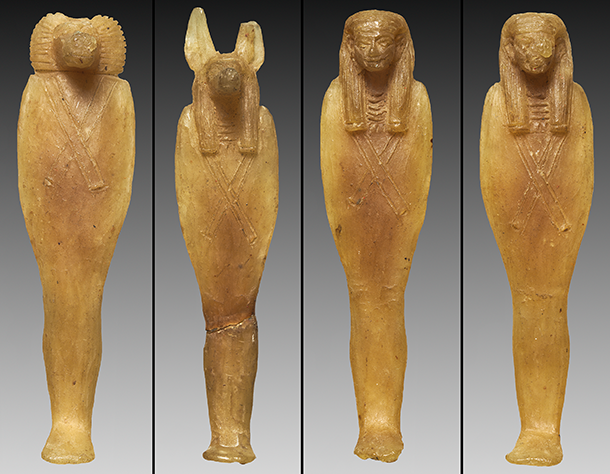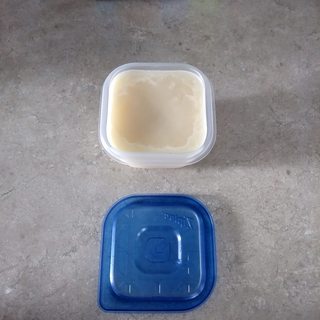Never found it an issue. Still offers plenty of advantages by absorbing salts.
Actually the beeswax acts as a preservative of sorts. I made several small cakes of the stuff several years ago, and they haven't gone rancid.
LD

Never found it an issue. Still offers plenty of advantages by absorbing salts.
Actually the beeswax acts as a preservative of sorts. I made several small cakes of the stuff several years ago, and they haven't gone rancid.
LD

I don't think you should of melted them down StumpyThese Egyptian beeswax figurines are 3,000 years old and not rancid.


Dutch, I thought that laying the patchs or strips was the way to go but I thought I would check to be sure. I'm always willing to learn a new trick.WHEN YOU HANG A FABRIC TO DRY, GRAVITY CAUSES THE LIQUID TO TRAVEL TO THE LOWEST PART AND THEN WHEN DRY THELUBRICANT WILL BE MORE EVIDENT ON THE THE LPWER HANGING PARTS AND THERE WILL BE NO CONSISTENCY IN THE SLICKNESS.
LETTING THE FABRIC DRY ON A FLAT HORIZINTAL NON ABSORBENT SURFACE IS THE ONLY WAY TO GO.
DUTCH
Sounds like a good mix.Rendered Bear Fat, Lanolin, And Beeswax. Nothing better in my opinion

Probably best to just quote his post on another forum. He prefaces his recipe with:Tell me more please?
Thank you.Probably best to just quote his post on another forum. He prefaces his recipe with:
"Do not use greases or oils that are petroleum-based. The older black powder manuals suggest using automotive grease over the chambers of revolvers. Don't do it. Petroleum-based greases somehow create a hard, tar-like fouling when combined with the black powder.
The proper grease or oil is animal or vegetable-based, such as Crisco, canola, beeswax, sunflower, commercial lard, mutton tallow and similar substances."
Then the meat of it:
"My own patch, wad and bullet lubricant is a 19th century recipe, found in a 1943 issue of the American Rifleman.
The recipe is:
1 part paraffin (I use canning paraffin, found in grocery stores)
1 part mutton tallow (sold by Dixie Gun Works)
1/2 part beeswax (available at hobby and hardware stores)
All measures are by weight, not volume. I use a kitchen scale to measure 200 grams of paraffin, 200 grams of mutton tallow and 100 grams of beeswax. This nearly fills a quart Mason jar.
Place the Mason jar in a pot or coffee can with about 4 inches of boiling water. This gives a double-boiler effect, which is the safest way to melt waxes and greases.
When the ingredients in the jar are thoroughly melted, stir well with a clean stick or a disposable chopstick. Remove from water and allow to cool at room temperature (trying to speed cooling by placing in the refrigerator may cause the ingredients to separate).
This creates a lubricant nearly identical to a well-known black powder lubricant sold commercially.
To use, place a small amount of the lubricant in a clean tuna or cat food can. Melt in a shallow pan of water. Drop your revolver wads or patches into the can and stir them around with a clean stick until all wads or patches are saturated. Allow to cool then snap a plastic lid (available in the pet food aisle) over the can and store in a cool, dry place. This keeps dust and crud out and retains the lubricant's natural moistness.
I don't bother to squeeze out the excess lubricant from patches or wads but use them as-is.
This is an excellent bullet lubricant for all black powder uses. I also use it for patches in my .50-caliber muzzleloading rifle, and lubricating cast bullets for my .44-40 and .45-70 rifles. I've tried it with .357 Magnum bullets at up to 1,200 feet per second and it prevents leading. I haven't tried it at a higher velocity in the .357 or other calibers, but may someday.
I like the addition of paraffin in this bullet lubricant, because it seems to stiffen the felt wad somewhat, and scrapes out fouling better.
I've used the Ox-Yoke Wonder Wads in the past and they're good, but lack enough lubricant for my likes. I soak them in the above lubricant.
With a well-lubricated wad twixt ball and powder, you can shoot all day without ever swabbing the bore."
These are FANTASTIC! Thanks for posting.These Egyptian beeswax figurines are 3,000 years old and not rancid.

Do not use greases or oils that are petroleum-based. The older black powder manuals suggest using automotive grease over the chambers of revolvers......
The recipe is:
1 part paraffin (I use canning paraffin, found in grocery stores)
How can you tell the difference?Not all paraffin is a petroleum by product, it can be derived from plants and even bees wax.
Robin
There is or was an odourless paraffin that my trapper friend swore by for lubricating his traps and another feller swore by it for worming dogs!As far as I know all paraffin wax petroleum based.
To the Brits "liquid paraffin" is kerosene.
As far as I know it is, and Gatofeo said he believed it was also. But he was quoting the mixture as published and also said he had never noticed any adverse effect from using the paraffin. Actually, neither have I.Well I thought that paraffin, for canning from grocery stores, WAS a petroleum product. ???
I dunno Steven. Seems like, if they went to the trouble it would be on the packaging.How can you tell the difference?
In South Africa one can buy "Liquid Parraffin" it is a plant-based oil used to clean out the stomachs of little kids (I know, I had it done to me, and it tasted just as terrible as Castor Oil) same as Castor oil. I have used it very successfully combining it with beeswax as a lube.